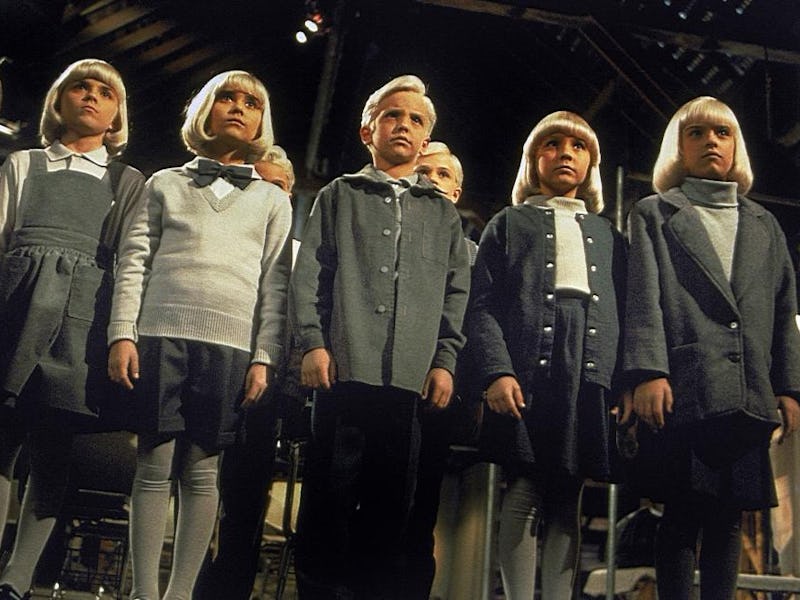30 Years Ago, John Carpenter Disappointed Sci-Fi Fans — And Himself
Mid-wich.

The second big screen adaptation of John Wyndham’s 1957 novel The Midwich Cuckoos, Village of the Damned flopped with critics and gorehounds alike, picking up a Razzie nod for Worst Remake and raking in less than half its $22 million budget at the domestic box office when it came out 30 years ago today. But the most damning indictment arguably came from the man who made it.
“I’m really not passionate about Village of the Damned,” director John Carpenter said to Vulture in 2011 when asked about the least favorite movie of his storied career. “I was getting rid of a contractual assignment,” he explained, referring to the one-for-you, one-for-me studio deal that was supposed to result in a new spin on Creature of the Black Lagoon.
This brutal dismissal was a wild contrast to the enthusiasm Carpenter showed for the project before its release. The 1960 original had made quite the impression on the horror maestro in his formative years, partly for the concept of an entire town suffering a simultaneous mental blackout and no doubt predominantly for how he developed an all-consuming crush on one of its stars (“I wanted her to zap me and take me over and make me do whatever she wanted.”).
Carpenter also expressed joy at being able to shoot in his Inverness hometown, how well he’d been treated by Universal throughout the creative process, and the script he’d rewritten to expand on both the aliens’ callousness and the Earthlings’ humanity. Unfortunately, little of this pride was in the finished product.
Village of the Damned is by no means the mess its reputation would suggest, but it commits the cardinal sin for a filmmaker renowned for subverting and revolutionizing his genre: it’s unremarkably, disappointingly workmanlike. Watching it feels like watching Carpenter simply go through the motions.
For those unfamiliar with the source material and its retellings, the ‘95 flop centers on the sleepy California town of Midwich, and the aftermath of a six-hour period in which all its residents are mysteriously knocked unconscious. Soon after, 10 women fall pregnant, including a teenage virgin and a woman who hasn’t slept with anyone for a year. These pregnancies, however, aren’t gifts from God.
The Midwich kids clearly aren’t alright.
Instead, as the locals soon discover, the five boys and five girls, all born on the same night, are part of an alien hive mind hellbent on destroying mankind. And with their rapid age-advancing powers — they grow from babies to Beatles-haired tweens in 12 months — it doesn’t take long for their master plan to shape up.
Initially, their actions are retaliatory, albeit completely disproportionate. On being served some slightly-too-hot soup, ringleader Mara (Lindsey Haun) possesses mom Barbara (Karen Kahn) and makes her burn her own hand in a pot of boiling water. And after briefly inconveniencing another malevolent munchkin, the town’s optometrist is forced to blind herself with a dangerous chemical.
The brood of Damiens soon up the ante, prompting Reverend George (an underused Mark Hamill) to shoot himself, scientist Susan (Kirstie Alley, in a rare non-comedic role) to commit suicide with a scalpel, and creepy groundsman Carlton (George Buck Flower) to jump off the school roof and impale himself with his broom. The kids are nothing if not resourceful.
As Carpenter acknowledges, the performances — particularly Christopher Reeve’s, in what would be his last before his paralyzing horse-riding accident — are the film’s saving grace. Haun is impressively sinister for a ten-year-old, issuing threats such as “If we coexist, we shall dominate you” and “We have to survive no matter what the cost” in a cold, clinical manner that proves the pint-sized tyrants means business.
Just another day in Midwich.
And even though ‘70s fanboys will be disappointed that the men best known as Luke Skywalker and Superman don’t get much chance to share the screen, the latter does bring some much-needed gravitas to proceedings. Determined to restore some harmony between the two species, Reeve’s town doctor, Alan, is the closest the film gets to a hero. Yet even his optimistic spirit eventually breaks, resulting in an impassioned takedown (“Without feelings, you're nothing. You're just second-rate mimics of a higher organism”) and a plot to eliminate the threat at the risk of his own life.
But despite Carpenter’s promise to better reflect modern times (the film’s predecessor wasn’t even allowed to mention impregnation, let alone abortion), the director largely fails to address the societal changes that had occurred over the previous 35 years. And while the briefcase bomb explosion — which obliterates Alan and all kids bar David (Thomas Dekker), the compassionate runt of the litter — ensures the film ends on a spectacle, the visuals elsewhere lack Carpenter’s usual flair. Village of the Damned often looks less like the product of an auteur’s imagination and more a generic TV movie.
Although Carpenter himself would disagree, Village of the Damned sits right in the middle of his inconsistent ‘90s run, behind return-to-form Escape from L.A. and Lovecraftian tale In the Mouth of Madness, but above bloodsucking schlock Vampires and Chevy Chase “comedy” Memoirs of an Invisible Man. Of course, anyone who’s seen the latter would know this is a pure example of damning with faint praise.